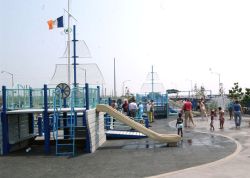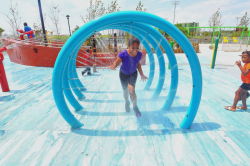Rockaway Beach and Boardwalk
Rockaway Beach Boardwalk
The origins of the name Rockaway Peninsula are closely related to the language of the Delaware and Chippewa Native Americans. Linguistic experts recognize both “Reckonwacky,” meaning “the place of our own people,” and “Reckanawahaha,” meaning “the place of laughing waters,” as the area’s indigenous names. Following the region’s European colonization during the seventeenth century, the present name was derived from these meanings. Other interpretations include “lekau,” meaning sand, and “lechauwaak,” for fork or branch. All interpretations reflect the historic and geographic traits of the peninsula.
The Canarsie Tribe, which originally inhabited the area, sold the mostly barren land to Captain Palmer, an Englishman, with a deed granted by then Governor Thomas Dongan in 1685. Disappointed with his purchase, Palmer sold the land in 1687 to a prominent iron master from Long Island, Richard Cornell, whose descendant, Ezra, founded Cornell University in 1865.
The Cornell family owned the land until 1808, when a partition suit divided the plot into 46 parcels, which were eventually sold to outsiders. The Rockaway Association, a group of wealthy New Yorkers, bought much of the property and began to build exclusive resorts in 1833. Within two years, James Remsen bought a large portion of the Peninsula. Remsen initiated a railroad project connecting the neighborhoods of Canarsie and East New York. The new railway was intended to greet steam ferries taking passengers to and from Rockaway. The Rockaway Peninsula remained a beachfront resort town, providing hotels, restaurants, and housing. During the 1890s, a variety of amusement parks were built. In 1897, the Village of Rockaway Park was incorporated into New York City.
Improvements in transportation, under the direction of Parks Commissioner Robert Moses in the 1930’s, led to the growth of Rockaway. The completion of two bridges, the Marine Parkway Bridge in 1937 and the Cross Bay Bridge in 1939, connected Rockaway to mainland Queens and Brooklyn. Innovations in railroad service and the development of the elevated subway allowed popular access to the peninsula. Subway access stimulated Rockaway’s transition from a vacation area to neighborhoods with permanent residents.
This section of Rockaway Boardwalk runs from Beach 73rd Street to Beach 109th Street, bounded by Shore Front Parkway and the Atlantic Ocean. The boardwalk, measuring 40 feet in diameter, extends through the neighborhoods of Hammels and Seaside. In 1938, Parks acquired the land through condemnation under the direction of Commissioner Robert Moses. Shore Front Parkway was built a year later. The beaches continue to attract over one million people each year.
Lifeguards are stationed on the beaches from Memorial Day through Labor Day. Visitors enjoy basketball and handball courts, roller-hockey rinks, sitting areas and playgrounds along the boardwalk and adjoining areas. Recent improvements to the area include the installation of “Whaleamena,” a sculpture of a whale that was originally part of the Children’s Zoo in Central Park. The whale was donated by Parks and subsequently restored by local volunteers. “Whaleamena” is located at the entrance to the Boardwalk at Beach 95th Street.
In 1999, for the first time in a quarter century, the entire boardwalk was open to the public following a multi-million dollar restoration project. The project included the repair of the boardwalk, the addition of spray showers and handicap accessible drinking fountains, and the installation of modern playground equipment between Beach 82nd and 86th Streets. The improvements also included the renovation of “The Wave” bus shelters. The interiors of the shelters now contain murals, painted by artist Ester A. Grillo, which depict aquatic scenes.
Check out your park's Vital Signs
Clean & Safe
Green & Resilient
Empowered & Engaged Users
Share your feedback or learn more about how this park is part of a
Vital Park System










